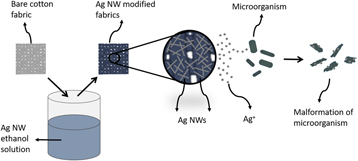Crossref Citations
This article has been cited by the following publications. This list is generated based on data provided by
Crossref.
Bahcelioglu, Ecem
Doganay, Doga
Coskun, Sahin
Unalan, Husnu Emrah
and
Erguder, Tuba Hande
2020.
A Point-of-Use (POU) Water Disinfection: Silver Nanowire Decorated Glass Fiber Filters.
Journal of Water Process Engineering,
Vol. 38,
Issue. ,
p.
101616.
de Menezes, Beatriz Rossi Canuto
Sampaio, Aline da Graça
da Silva, Diego Morais
Montagna, Larissa Stieven
Montanheiro, Thaís Larissa do Amaral
Koga Ito, Cristiane Yumi
and
Thim, Gilmar Patrocínio
2021.
Nanocomposites obtained by incorporation of silanized silver nanowires to improve mechanical properties and prevent fungal adhesion.
Nano Select,
Vol. 2,
Issue. 12,
p.
2358.
Doganay, Doga
Cicek, Melih Ogeday
Durukan, Mete Batuhan
Altuntas, Burak
Agbahca, Erdem
Coskun, Sahin
and
Unalan, Husnu Emrah
2021.
Fabric based wearable triboelectric nanogenerators for human machine interface.
Nano Energy,
Vol. 89,
Issue. ,
p.
106412.
Bahcelioglu, Ecem
Unalan, Husnu Emrah
and
Erguder, Tuba Hande
2021.
Silver-based nanomaterials: A critical review on factors affecting water disinfection performance and silver release.
Critical Reviews in Environmental Science and Technology,
Vol. 51,
Issue. 20,
p.
2389.
Qian, Liying
He, Duoduo
Qin, Haiming
Cao, Xiuhua
Huang, Jun
and
Li, Junrong
2022.
Chitosan fabrics with synergy of silver nanoparticles and silver nanowires for enhanced conductivity and antibacterial activity.
Journal of Industrial Textiles,
Vol. 51,
Issue. 1_suppl,
p.
1279S.
Altinkok, Cagatay
Acik, Gokhan
Daglar, Ozgun
Durmaz, Hakan
Tunc, Ilknur
and
Agel, Esra
2022.
A facile approach for the fabrication of antibacterial nanocomposites: A case study for AgNWs/Poly(1,4-Cyclohexanedimethylene Acetylene Dicarboxylate) composite networks by aza-Michael addition.
European Polymer Journal,
Vol. 169,
Issue. ,
p.
111130.
Basturkmen, Berk
Ergene, Emre
Doganay, Doga
Yilgor Huri, Pinar
Unalan, Husnu Emrah
and
Aksoy, Eda Ayse
2022.
Silver nanowire loaded poly(ε-caprolactone) nanocomposite fibers as electroactive scaffolds for skeletal muscle regeneration.
Biomaterials Advances,
Vol. 134,
Issue. ,
p.
112567.
Zhao, Yonghe
Lu, Qinqin
Wu, Junzhi
Zhang, Yuhan
Guo, Jiabao
Yu, Jingjie
Shu, Xinrui
and
Chen, Qiang
2023.
Flexible, robust and self-peeling PLA/AgNWs nanofiber membranes with photothermally antibacterial properties for wound dressing.
Applied Surface Science,
Vol. 615,
Issue. ,
p.
156284.
García Vélez, David Giancarlo
Lagos Álvarez, Karina Janneri
and
Romero Obando, María Paulina
2023.
Biotechnology - Biosensors, Biomaterials and Tissue Engineering Annual Volume 2023.
Vol. 20,
Issue. ,
Doganay, Doga
Demircioglu, Onur
Cugunlular, Murathan
Cicek, Melih Ogeday
Cakir, Onuralp
Kayaci, Huseyin Utkucan
Aygün, Simge Çınar
and
Unalan, Husnu Emrah
2023.
Wet spun core-shell fibers for wearable triboelectric nanogenerators.
Nano Energy,
Vol. 116,
Issue. ,
p.
108823.
Shayo, Godfrey M.
Elimbinzi, Elianaso
and
Shao, Godlisten N.
2024.
Water‐based technologies for improving water quality at the point of use: A review.
WIREs Nanomedicine and Nanobiotechnology,
Vol. 16,
Issue. 1,
Zhu, Yehan
Fu, Jiayi
Ou, Zongquan
Tao, Xiaole
Yan, Tao
and
Pan, Zhijuan
2024.
Poly(3-hydroxybutyrate)/Poly(lactic acid) Composite Nanofibrous Membrane with Outstanding Photochromic and Antibacterial Performances for Multifunctional Applications.
ACS Applied Polymer Materials,
Vol. 6,
Issue. 16,
p.
9883.
Lee, Chankyoung
Park, Jaewoo
and
Choi, Dooho
2024.
Enhancing Thermoelectrical Properties of Silver-Nanowire-Embedded Heatable Textiles via Sputter-Mediated Nanowire Structural Modulation.
Materials,
Vol. 17,
Issue. 22,
p.
5514.
Lee, Hyeon Jae
and
Choi, Dooho
2024.
Fabrication of Heat-generating Polyester through Formation of Conductive Silver Nanowire Network.
Korean Journal of Metals and Materials,
Vol. 62,
Issue. 8,
p.
639.
Lee, Il Hyun
Woo, Chae Young
Seo, Youngho
Lee, Sangsu
Kim, Han‐Jun
Lee, Hyung Woo
and
Jeon, Il
2025.
Advanced Facial Mask Using Roll‐to‐Roll Processed Superhydrophobic Vertically Aligned Carbon Nanotubes for Enhanced Antiviral Effects and Reusability.
SusMat,
Yue, Wang
Shuchang, Li
Zhen, Lian
Fengguo, Liu
and
Changsheng, Lou
2025.
Enhanced Surface Antibacterial Properties of Gray Cast Iron by Aging Precipitation of Cu Phase.
Journal of Materials Engineering and Performance,
Vol. 34,
Issue. 3,
p.
2052.



